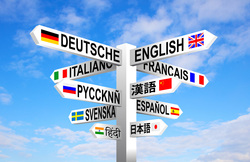
Preferences for content vary by continent. Companies looking to expand operations overseas will inevitably face cultural and language barriers. They will have to think about how content is resonating with global audiences and they will face the challenge of determining which content to adjust to meet the needs of local markets.
To help ensure a quality customer experience, the top global brands employ a localization strategy to adapt their online content for regional specificity. Content should clearly resonate with companies' international audiences.
Content localization is the process of modifying content to make it usable for a new locale. Often, this includes translating the content from the source language into the language used in the locale. It is an integral part of adapting a product for a particular market. For example, if a company is currently selling products in US and is expanding into France, the company would need to translate the content into French.
Content translation and localization are not the same. Translation is the process of changing an original language of content into a different language. Content localization is a more specialized process of adapting content for regional or local consumption. It goes beyond translation to modify the source language and other site elements to appeal to the customer’s cultural preferences in their own target language. Localization is about refining your message and curating your brand to meet the cultural, functional, and language expectations of your global markets.
Why to localize the content? There are few reasons:
- catering to local customers - to show your local customers that you care about them and to bring more value to your products;
- reduce risks - to avoid liability by not using words that might be offensive in a different country;
- enhance marketing - having a great campaign or advertisement is useless if your target audience doesn’t speak English well enough to understand your marketing message;
- increase sales - localized content will sell more often because consumers will be able to fully understand what they are buying.
These are standard best practices that help to minimize the cost of localization:
Content Development:
- source text should use clear, simple, concise language;
- do not use jargon, idiom, metaphors, or other creative language;
- use simple words;
- use simple language structure;
- use consistent terminology
- limit text in graphics, and put text into an editable layer;
- use legends rather than embedded text for graphics.
- use predictable structure;
- use styles or structured authoring;
- do not use embedded formatting.
Include a language flag on content so the system can deliver content to readers in the language they want.
Localization
- use professional translators;
- use translation memory systems;
- work with localization professionals to identify potential problems;
- look for opportunities to change source content instead of requiring changes in each target language.
- use color carefully because colors meaning varies across cultures;
- images of people are not appropriate in some cultures and in other cultures, images of women are not acceptable;
- images of hands or feet are not appropriate in some cultures;
- when designing icons make sure that they are universally understood.
- colors, shapes, sizes, styles;
- images, icons, graphics;
- societal codes; i.e. humor, etiquette, rituals, myths, symbols;
- societal values, power, relationships, beliefs.
- date and time formats, telephone numbers, contact information;
- weights, measurements, geographical references;
- language and linguistic content; product descriptions, reviews.
There are several content types, from marketing collateral to legal and technical information and user-generated forum content. For reasons of efficiency and cost, is is the best practice to map these content types to the most appropriate translation or localization methods.
Not all company's content needs to be translated. Companies that located in one location should make it a priority to determine which content should be tailored for various regions. For example, blogs and tweets are not as significant as marketing and training materials, one help sheets, business forms, support email, FAQs.
It is generally easier to select the best fit when you consider your audience and the content’s source and intent. Other parameters include volume, update frequency, content lifecycle, and budgetary considerations. Depending on your language service provider’s (LSP) capabilities, there are several methods from which to choose. When making these decisions, it’s best to consult an experienced LSP that offers a wide range of services.
Following these best practices will help to reduce the overall cost of localization. Translators very often use memory tools and following these best practices would help these tools to recognize the same patterns.
Companies can try to discover which locales and languages provide the greatest return on investment. Identify languages that make up 90% of global online economic opportunities.
Be sure to follow industry best practices to reduce complexity, speed time-to-market, control costs and ensure quality localized content for all of your global markets. Companies will need to adopt stronger content strategies, keep closer tabs on the ways in which customers are consuming content, and take into consideration consumer preferences based on geographical region and digital trends.
Achieving global excellence means improving local experiences and getting better insights into those markets.
 RSS Feed
RSS Feed
